|
Improve your rowing performance off the water with key stretches and triggering exercises to increase power through the water and stroke efficiency. In our previous blog we discussed how stretching, strengthening and injury prevention can help to significantly improve your on water performance. In part two of blog we discuss, in detail how to stretch and foam roller techniques specific for muscles used in rowing. 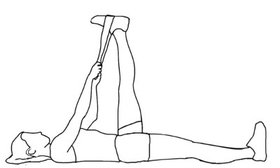 Hamstring Stretch Reason: Helps you rock over at the finish, aids in stopping you from opening up your body early. Timing: 1:30 min/ side Position: Lying on your back put a towel/ strap around the middle of your foot, take the leg up to where you feel a stretch. Make sure your knee is not bent and your pelvis does not move as you move into position. Direction of stretch: Use the strap as resistance. Push away from your body, through your knee. 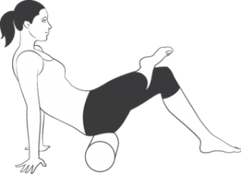 Foam Rolling on your Gluts (Butt Muscles) Reason: Decreases load on your lower back, helps with rock over at the finish. Major muscle group used in rowing that gets very tight and can contribute to lower back pain. Timing: 1 min - 2 mins Pain Scale: 5/10 Position: Sit on the roller. Hands behind the roller helps to take some of the weight of your body. Lift the leg you want to loosen and cross it over the top of the other. Tilt your hips so you are sitting a little more on the fleshy part of your pelvis. Roll back and forth ensuring you hit all muscles around the hip. 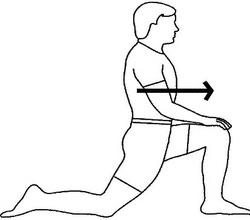 Hip Flexor Stretch Reason: Decreases the load on your lower back. Major muscle group used in rowing that gets very tight and can contribute to lower back pain. Timing: 1:30 mins/ side Position: One hip flexed to 90 degrees, with the same knee bent and foot out in front of your body. The other leg with hip extended and knee on the ground. (You way need a pillow to protect your knee.) Direction of stretch: Push your hips forward so that you feel the stretch in the front of the leg which has the knee on the ground. 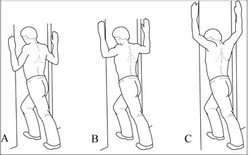 Pectoralis Major (Pec) Stretches Reason: Loosening your pecs will help with general posture in the boat; Opening up through your chest and drawing your shoulders down and back at the finish. This contributes to keeping your blades in the water and maintaining power at the finish of your stroke. Also aids in reducing shoulder impingement injuries. Timing: 30sec in 3 positions shown / side Position: In a door way, with your body parallel to the doorway. Lift your arms so that they start in position B shown above. Reposition your arms to positions A and C after 30 seconds. Direction of stretch: Push your body into the doorway so you feel the stretch through your chest. 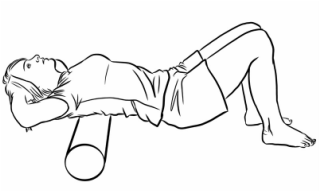 Thoracic Mobility: Reason: Helps with keeping blades in the water, aids in a stronger finish position including not lifting your shoulders up at the finish to take the blades out of the water. Adequate thoracic mobility is essential for sweep rowing and decreasing chances of rib stress fractures. Timing: 1 min - 2 mins Position: Knees bent, feet flat on the ground. Foam roller in the middle of your spine, arms back and behind your head to support it. Roll back and forth from just above the small of your back to between your shoulders blades. To loosen more of the muscles between your shoulders blades bring your elbows together in front of your body. Pick 3 spots - one slightly lower, one right in the middle of your spine and one on your upper back and arch over the foam roller in these positions. Take 3 deep breaths whilst on the spot and then continue to roll. (Be careful not to spend too long on these spots as it can cause irritation of the spinal region) 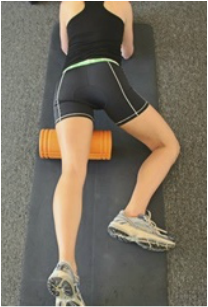 Foam Rolling of the Quads, Hip Flexors and Adductors. Reason: These major muscle groups used in rowing, can become too tight which can contribute to lower back and knee pain. Timing: 1 min to 2 mins per leg. Pain Scale; 5/6 out of 10 Position: Place one leg on the foam roller and one leg off the foam roller as shown in the diagram to the right. Support your weight with your forearms and the knee/foot that is not on the foam roller. Roll all the way from the top of your hips down to your knee. With each roll change the position of your foot to rotate your leg inward and outward. This allows you to target more muscle groups such as your adductors and your lateral (outside) quads and hip flexors. 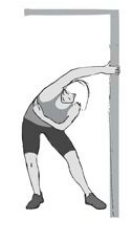 Lat Stretch Reason: Major muscle group used in rowing. If too tight your shoulders are pulled forward. Helps with rowing posture and preventing shoulder injuries. Timing: 1:30min per side Position: With one arm over your head find a doorway or a pole and hang off it. Direction of Stretch: Pull away your body away from the supporting arm so you feel the stretch through your upper arm and side. The stretch can sometimes be felt all the way down to the side of your pelvis. Stretching Essentials:
References:
Stretching/ Exercises: (NCRE Flexibility Exercises) http://www.rowingaustralia.com.au/docs/nrce-flexibility-exercises-2010.pdf Pictures: http://hpsm.ca/my-hpsm/exercise-tutorials/foam-roll massage http://www.myvmc.com/lifestyles/exercise-_stretches/ http://www.osteoarthritisblog.com/osteo-arthritis-treatment-option/exercise-osteo-arthritis-treatment-option/2854-hip-flexor-stretch www.theepochtimes.com http://beyondfitness.co/featured-exercise-side-lying-thoracic-rotation-stretch http://www.menshealth.co.uk/fitness/sports-injuries/4-foam-roller-exercises http://paulsfitnessblog.blogspot.com.au/2011/06/stretching.html https://www.youtube.com/watch?v=kcrUkWlKV1Ahttp://blog.iruninspired.com/tag/tennis-ball/ http://www.physique-mag.com/site/index.php/2012/11/benefits-of-myofascial-release-2/ http://morganmassage.com/wp-content/uploads/2014/05/download-300x216.png http://www.somastruct.com/wp-content/uploads/2012/11/TowelStretch.jpg Comments are closed.
|
AuthorKat Murray, Archives
May 2024
Categories
All
|

 RSS Feed
RSS Feed